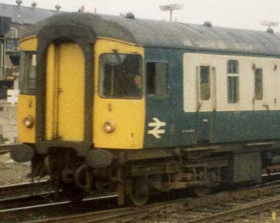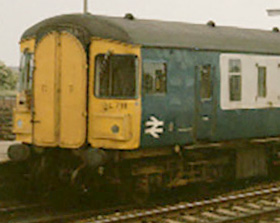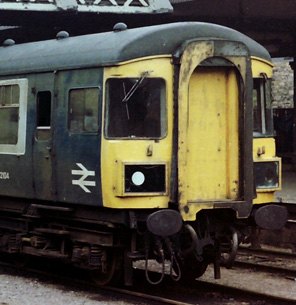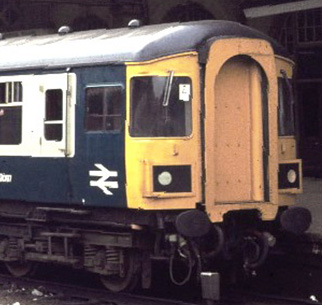Class 123 Swindon 4-car DMUs
Liveries
Green with yellow gangways

The sets were delivered in Loco green, with cream lining. The roofs were carriage grey, with a white roof canopy at the leading ends. The bogies and underframes were black. When these sets were delivered, speed whiskers had been replaced by yellow warning panels, but their front gangway and route indicators left little room for these. Instead the front gangway had a yellow moulded plastic cover fitted. Over the years a variety of types of these covers were used, including old flat top wood / canvas ones, curved top fibreglass ones, or on occasions none at all.
The image shows a set at Salisbury led by W52100 on the 9th March 1968. David Mant.
Rail Blue

Being Inter-City units they bypassed the all-blue stage and went straight into blue / grey, but there seems to have been at least one exception to that rule. Tim Hall notes "I have a clear memory of one vehicle, a TS, painted in blue, in an 8-car formation of otherwise mixed green and blue/grey stock, in about 1970. I only remember seeing this vehicle once, so I assume it got repainted in blue/grey soon after."
The image probably shows that vehicle, seen at Cardiff Central on a Pompay train, as part of a half set added for strengthening around Easter 1968. Stuart Davies.
A plain blue vehicle can also be seen in this image on flickr, also as part of a half set, possibly the same vehicle.
Blue and Grey

W52086 seems to be the first Class 123 to be painted in Blue and Grey, emerging from Swindon Works in Summer 1967.
In the image E52091 still carries its L711 set number when seen at Hull Paragon on 3rd November 1978. Syd Young.
The single piece gangway covers had been lost by this period, the folding version seemed to be black initially, but would become yellow later. The gangway door behind the cover would be painted yellow, visible if a cover was not fitted. The gangway rubbing plate would often also be painted yellow, although sometimes this would only be the left side.
Grey variations
There were some variations in the extent of the grey band on the power cars, and these seemed consistant through all the blue/grey era, from the late 1960s till withdrawal.
On nine of the ten DMBSL vehicles the grey encompassed the inward opening guard's door, as seen on the first image below. On just one vehicle - 52091 - it didn't, as seen on the second image.


On most DMSL vehicles the grey band would stop before the door at the cab end (first image below). On three of the ten vehicles (52096/7/9) the grey band included the cab door (second image below).



Blue and Grey with Trans Pennine markings
A set in the old Green Eyre platform at Lancaster Castle on the 19th August 1982, formed E52100, E59766, E59836 and E51952. Robert Frise.
Summary
Description
Interior
Diagrams & Design Codes
Works Photographs
Numbering & Driving Inst.
Liveries
Operations
Non-Passenger Use
Images
No Class 123 vehicles were preserved.


